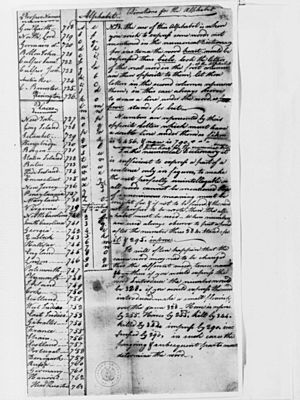Cato (spy) facts for kids
Quick facts for kids Cato |
|
|---|---|
| Allegiance | |
| Service | Continental Army, American Revolutionary War |
| Rank | Enslaved person |
|
|
|
| Nationality | American |
| Occupation | Spy, courier |
Cato Howe was a brave African American man who was enslaved. He became an important spy and messenger during the American Revolutionary War. This war was when the American colonies fought for their freedom from Great Britain.
Cato worked for his enslaver, Hercules Mulligan, who was a tailor in New York City. Mulligan gathered secret information from his friends and customers. Cato then carried these important messages on horseback. He delivered them to American leaders like Alexander Hamilton and George Washington. Often, he had to travel through areas controlled by the British army. Cato's messages are believed to have saved George Washington's life two times. We don't know much else about Cato's life, but his actions as a spy were very important.
Contents
Cato's Role in the American Revolution
It's hard to know everything Cato and Mulligan did during the war. This is because many of their secret messages don't exist anymore. Many people like Cato, who were not famous, helped in the American Revolution. Their contributions have often been forgotten. Historians say Cato was a "faithful accomplice" to Mulligan, meaning he was a loyal and helpful partner.
Cato joined the army in 1775 as a private soldier. He served in the 2nd Massachusetts Regiment. In 1778, he was given his freedom because of his service.
Working with Spies
Cato and Mulligan were spies at the same time as the famous Culper Ring. This was a group of American spies organized by George Washington. Some historians believe Cato and Mulligan started spying even before the Culper Ring was officially formed. They often worked on their own, separate from the main spy group.
The Hessian Plot
Cato helped with a clever plan involving Mulligan and Haym Salomon. Salomon was an American supporter who had been captured by the British. He was released to work as a translator for the British and their German soldiers, called Hessians.
The plan was to get information from the Hessian officers. Mulligan sent Cato to Salomon's shop with advertisements for his tailoring business. Salomon would translate these ads into German for the Hessians. When Cato returned, he brought back the translated ads and secret information. Mulligan then shared this information with Hamilton and Washington.
Crossing Enemy Lines
The British soldiers didn't suspect that an enslaved person would be a spy for George Washington. Because of this, Cato could often move freely. In April 1777, he was allowed to cross the Hudson River on a ferry. He carried packages that contained secret information about British General William Howe's plans. Many British soldiers knew Cato because they were Mulligan's customers. They let him pass to New Jersey and return to New York with packages marked "H. Mulligan, clothier."
Later, a British officer named William Cunningham became suspicious of Mulligan. He also wondered about Cato's trips out of New York. Cunningham eventually questioned Cato and put him in jail. He treated Cato badly and tried to make him talk about Mulligan's activities. But Cato was very brave and refused to say anything.
Saving Washington's Life
Cato's quick actions saved George Washington's life at least twice.
In the winter of 1779, a British officer came to Mulligan's tailor shop. He accidentally shared a British plan to attack and capture Washington the next day. Cato was immediately sent to warn Washington. Washington moved his troops, and the British attack failed.
In 1780, Mulligan learned that the British planned to ambush Washington. This was when Washington was traveling to meet with a French general. Cato carried this urgent message to Washington. Washington changed his route, which not only saved him but also helped distract the British. This allowed French troops to land safely in Newport, Rhode Island.
Cato was officially discharged from the army in 1783, when the war ended.
Life After the War
After the war, Cato returned to Plymouth, Massachusetts. In 1792, the town offered land to anyone who could clear it. Cato, along with three other men named Prince Goodwin, Plato Turner, and Quamany, took on this challenge. They created a small community on their new land. They called it Parting Ways or New Guinea.
Cato lived there for the rest of his life. He lived with his first wife, Althea, and later with his second wife, Lucy Prettison. Cato passed away in 1824 and is buried on the land he owned in Plymouth.
Cato in Popular Culture
The Culper Ring and other spies are shown in the TV show Turn: Washington's Spies. This show is based on a book about America's first spy ring. Mulligan and Cato appear in the show's fourth and final season.
Hercules Mulligan is also a character in the famous Broadway musical Hamilton. However, Cato is not mentioned in the musical.


